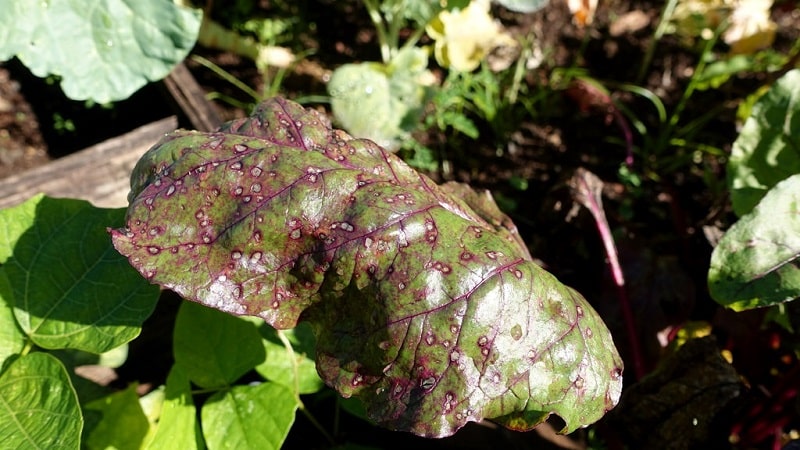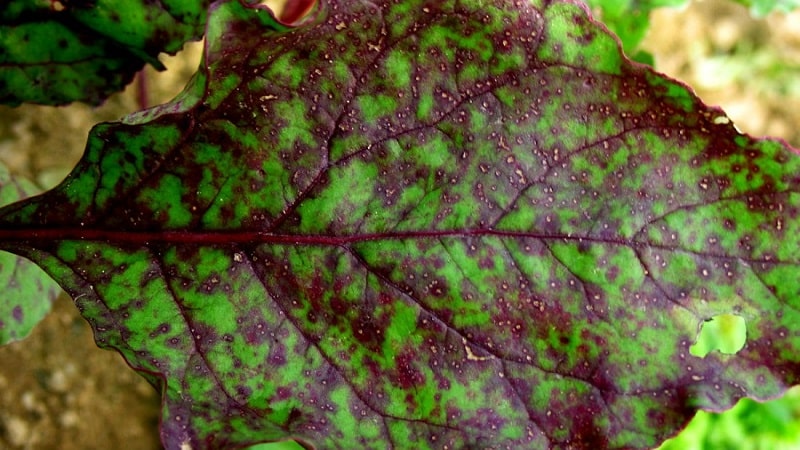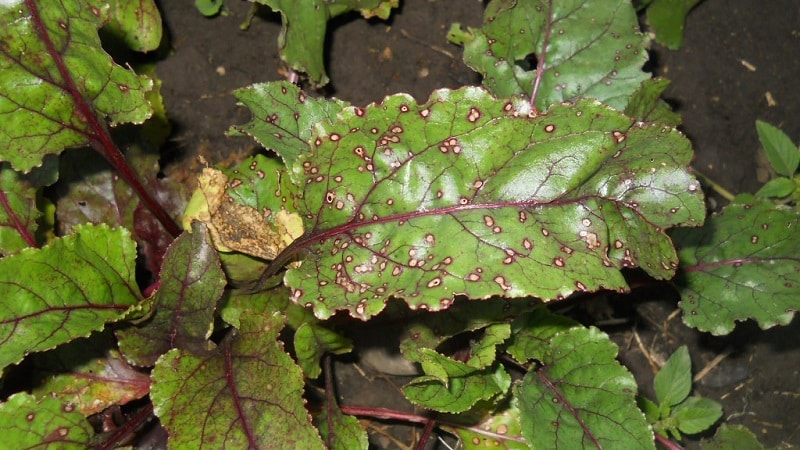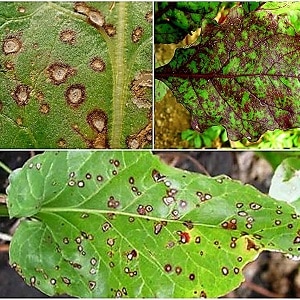How to treat beet cercospora and prevent the occurrence of this disease in the future
Paracelsus used beets to treat anemia back in the 16th century. But despite its healing properties, the plant itself is susceptible to many diseases. One of them is cercospora blight. Read about the symptoms of the disease and measures to combat it in our article.
What is beet cercospora
Cercospora blight is a fungal infection. The causative agent is Cercospora beticola. It overwinters as a mycelium in dead leaves and petioles and is stored in seed balls. The pathogen remains viable only in the upper layers of the soil (no deeper than 10 cm) or on plant debris located on the soil surface. In the spring it forms spores, which serve as the primary source of infection.
Infection occurs by penetration of spores into plant tissue through stomata and mechanical damage.
The incubation period in summer is 7-10 days, in cool spring or autumn - up to 30 days. A temperature of 15-35ºC is favorable for sporulation of the fungus. When raised to 40ºС, the development of the pathogen stops. The fungus spreads quickly at humidity levels of 98-100%; levels below 88% are detrimental to the pest. Sunlight inhibits the formation of spores.
Cercospora blight leads to pathological changes in the functioning of the leaf apparatus. In infected plants, the level of transpiration (physiological evaporation of water) increases, which leads to an imbalance of nutrients in the tissues.The absorption of carbon dioxide decreases 10 times, and nitrogen metabolism deteriorates.
Maintaining leaf growth is due to the forces of the root crop. By fall, new leaves may grow and the rows will look healthy. However, full-fledged root crops will not form, the yield will decrease by 30-70%. When stored like this beet is rotting.
The disease is most common in western Ukraine, Kazakhstan and the Krasnodar region. In the Central Black Earth Region and Siberia it occurs less frequently and on a smaller scale.
Reference. Cercospora blight affects not only beets, but also potatoes, soybeans, peas and other crops.

Reasons for appearance
The appearance of fungus on plants is caused by heat that lasts more than 40 days with temperatures above 25ºC during the day and above 15ºC at night. A mandatory factor is humidity above 70% for a long period. With a rainfall of 180-200 mm during the summer, the likelihood of infection increases many times over.
Symptoms
The first signs of the disease can be detected in June-July.
Small round spots of light brown color appear on the leaves, surrounded by a pronounced red-brown border. At first, the diameter of the lesions does not exceed 0.5-0.8 mm; as the infection develops, they increase to 2-4 mm.
First of all, the disease is noticeable on the outermost leaves in the rosette. Slightly depressed, elongated light brown spots are visible on the petioles and stems.
With high humidity, a velvety gray coating appears on the lesions.
If you do not fight cercospora blight, the leaf blades curl, wither and die. Tops lies on the soil, the row spacing opens.
To maintain life, the plant spends nutrients intended for the growth of root crops on the growing season of young leaves.

Fighting methods
Methods of combating infection are divided into two groups: agrotechnical and chemical. There are no effective folk methods for treating beet cercospora.
Agrotechnical measures
Before planting vegetables, measures are taken to destroy overwintered pathogens. The site is inspected and all remains of rotten plants are removed. Pre-sowing soil preparation consists of deep digging, if this has not been done in the fall, and thorough loosening to a fine lumpy state.
During the growing season, it is important to maintain the top layer of soil in a loose state, which improves air access to root crops and retains moisture.
It is necessary to weed the beds in a timely manner. Weeds depress beets and serve as a source of diseases and various pests.
Fertilizing will save the plantings from starvation diseases. At the first signs of cercospora blight, potassium-phosphorus fertilizers should be applied.
Reference. Agrotechnical measures are aimed at maintaining general health and strengthening plant immunity.

Chemicals
In June and the first half of July, at the first signs of the appearance of cercospora pathogens, beets are treated with fungicidal preparations.
Effective in combating them:
- "Fundazol" ("Benomyl") belongs to the class of benzimidazoles and has a wide spectrum of action against most fungal infections. It is used for treating plants and treating seeds. The action is based on disruption of the reproductive function of the fungus. The drug has a systemic effect, as it is partially absorbed by plant tissues; most of it remains on the surface of the leaves and has a contact effect on pathogenic organisms. Available as a 50% wettable powder. To treat the beds, dilute 10 g of the drug in 10 liters of water.Consumption of working solution: 1.5 liters per 10 m². Pests may become resistant to the pesticide, so it must be alternated with others. The substance is not toxic to bees, but is dangerous to humans, animals and fish.
- "Kuprozan" ("Homecin") is a contact fungicide. It is a mixture of 4 parts copper oxychloride and 1 part zineb. Produced in powder form. To prepare a working suspension, take 40 g of the drug per 10 liters of water. Consumption - about 1 liter per 10 m². Low toxicity to bees; moderate toxic effects on humans and animals.
- Copper oxychloride (CHOM) - inexpensive drug with protective contact action. It is recommended to be used as a prophylactic before symptoms of the disease appear. The frequency of treatments is 3 times per season with an interval of about 2 weeks. Liquid for treating plants is prepared from 40 g of the substance per 10 liters of water. Spraying is carried out at the rate of 1 liter per 10 m². Poses moderate danger to humans.
Spraying against cercospora is carried out only in wet weather, after heavy rains or dew. The air temperature should be 20-25ºС. Treatments in cool weather (about 15ºС) are ineffective. It is not recommended to use fungicides during dry and hot periods.
Treatments must be carried out no later than 30 days before harvest.
Important! When working with chemicals, be sure to wear closed clothing, a hat, rubber gloves, a respirator and safety glasses. After work, the face and hands are thoroughly washed, and clothes are washed.

Prevention
 There are several effective methods to protect beet plantings from the causative agent of cercospora blight.
There are several effective methods to protect beet plantings from the causative agent of cercospora blight.
First, you need to follow the rules crop rotation. Sowing beets in their original place no earlier than two years later helps to avoid the accumulation of pathogenic microorganisms.
Secondly, immediately after harvesting the root crops, the remains of the tops are completely removed from the beds. They can be used as animal feed.
Thirdly, areas for beets are dug deeply in the fall. Fungal spores at a depth of more than 10 cm will lose viability during the winter.
Finally, varieties that are resistant to the disease should be selected. For example, Incomparable A-463, Mulatto, Bravo, Rocket F1 hybrid.
Conclusion
Beet cercospora is a serious disease that reduces the yield by 30-70%, the quality and keeping quality of root crops. The causative agent of the infection, the fungus Cercospora beet, develops in a humid and warm environment. The first signs appear in June-July in the form of small round spots with a red-brown border. At an advanced stage of the disease, the leaves curl, wither and die. Control measures include proper agricultural technology (timely weeding, loosening, fertilizing) and treatment with fungicides.
Crop rotation, deep autumn digging of areas for beets, and removal of all plant debris from the beds serve as excellent prevention of cercospora disease. Attentive attitude to plants, regular inspections for the presence of pests and infections will help you notice the problem in a timely manner and eliminate it without significant effort.